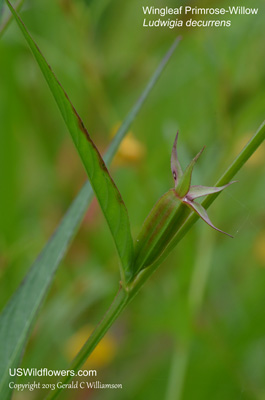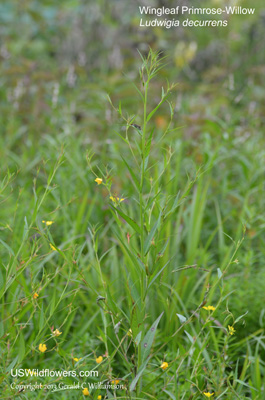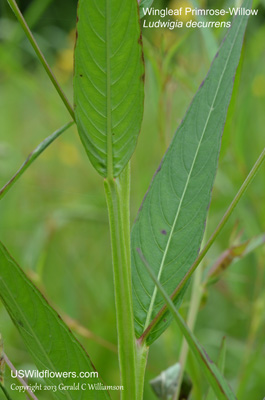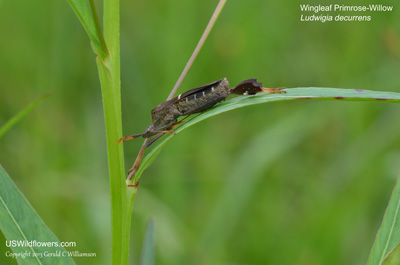Wingleaf Primrose-willow, Wingstem Water Primrose, Willow Primrose, Upright Primrose-willow - Ludwigia decurrens
|
Ludwigia decurrens - Wingleaf Primrose-willow, Wingstem Water Primrose, Willow Primrose, Upright Primrose-willow. Ludwigia is a genus with over 80 species worldwide, and the USDA Plants Database lists 33 species in the United States and territories, with all but 3 being native. Only 6 states do not have a Ludwigia species (Alaska, Montana, Wyoming, Utah, North Dakota, South Dakota.) Ludwigia decurrens is plant that is native to the southern two-thirds of central and eastern United States. While it is protected as Rare or Endangered in Indiana and Pennsylvania, it has naturalized and is considered an obnoxious weed in California. It grows in wet or marshy area, and is sometimes aquatic. Fragments of the plant will root in a day or two in water.
Found in:
AL, AR, CA, DC, FL, GA, IL, IN, KS, KY, LA, MD, MO, MS, NC, OH, OK, PA, SC, TN, TX, VA, WV
Leave comments on Ludwigia decurrens at this link. | 
Distribution of Ludwigia decurrens in the United States and Canada:

Blue=Native; Grey=Introduced
Map from USDA Plants Database:
USDA, NRCS. 2017. The PLANTS Database (http://plants.usda.gov, 16 Jan 2025). National Plant Data Team, Greensboro, NC 27401-4901 USA.
Search Our Database: Enter any portion of the Scientific, Common Name, or both.
Do a general Google search of the entire site:
#ad
 Follow USWildflowers on Twitter
#ad
| | Site: Riverwalk, Amnicola Marsh, Hamilton County, TN Date: 2013-August-17 | Photographer: Gerald C. Williamson
Nikon D7000
Tamron SP 90MM f/2.8 AF Macro | | Wingleaf Primrose-willow has four bright yellow petals on the blossom which is about 1 inch across, a bit larger than the similar Ludwigia alternifolia (Seedbox.) | | 
| | Site: Riverwalk, Amnicola Marsh, Hamilton County, TN Date: 2013-August-17 | Photographer: Gerald C Williamson
Nikon D7000
Tamron SP 90MM f/2.8 AF Macro | | Some folks refer to the Ludwigia genus as "Seedbox" rather than "Primrose-willow" because of the boxy seed capsules most (perhaps all?) species have. However, these seed capsules have different shapes, with, for example, Ludwigia alternifolia having mostly cube-shaped capsules, while this species, Ludwigia decurrens has an elongated seed capsule which, like L. alternifolia, is square in cross-section. | | Click on the photo for a larger image

| | Site: Riverwalk, Amnicola Marsh, Hamilton County, TN Date: 2013-August-17 | Photographer: Gerald C Williamson
Nikon D7000 | | Ludwigia decurrens is the tallest of the Primrose-willows, growing up to 6 feet tall. Although usually an annual, the stem is somewhat woody and may in some circumstances exist as a perennial. | | Click on the photo for a larger image

| | Site: Riverwalk, Amnicola Marsh, Hamilton County, TN Date: 2013-August-17 | Photographer: Gerald C Williamson
Nikon D7000 | | The alternate leaves of Ludwigia decurrens are "decurrent" - the leaf base extends down the stem as "wings". It is the only Ludwigia with winged stems. | | Click on the photo for a larger image

| | Site: Riverwalk, Amnicola Marsh, Hamilton County, TN Date: 2013-August-17 | Photographer: Gerald C Williamson
Nikon D7000 | | Clearly the leaf of Wingleaf Primrose-willow makes a comfortable resting spot. | | Click on the photo for a larger image

|
References used for identification and information:
|
|
| |
| #ad
|
|







